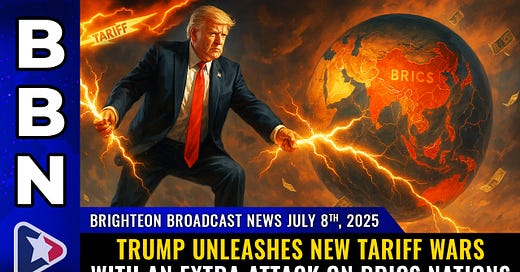President Trump’s aggressive new tariffs—a 25% levy on allies like Japan and South Korea and a 10% surcharge on BRICS member nations—are accelerating a seismic shift in global trade dynamics. Experts warn the move is backfiring, pushing countries like China, Russia, and India to fast-track alternatives to the U.S. dollar and deepening global economic fractures.
Tariffs as a Double-Edged Sword
Trump’s tariffs, touted by supporters as a win for American industry, are designed to penalize imports and boost domestic manufacturing. But critics argue they’re hastening the decline of the dollar’s dominance. "The math doesn’t add up," said independent analyst Mike Adams. "These tariffs may bring in 121 billion, but the U.S. just added 5 trillion in debt. It’s a drop in the bucket—all while pushing the world toward dumping the dollar."
The ripple effects are profound. Japanese and South Korean manufacturers, slapped with a 25% tariff, are already eyeing pivot strategies, diverting exports to non-U.S. markets. Meanwhile, BRICS nations—Brazil, Russia, India, China, South Africa, and newly admitted Vietnam—see Trump’s 10% surcharge as further proof that dollar reliance is a liability.
The BRICS Endgame: Gold-Backed Settlements
A quiet financial revolution is unfolding. BRICS nations are building a gold-backed settlement system to bypass dollar-based trade entirely. Russia and China lead the charge, stockpiling gold and establishing multi-nation depositories where imbalances are settled in bullion rather than greenbacks.
"Trump’s tariffs are the best advertisement for BRICS," Adams noted. "Every punitive measure pushes these countries closer to a system where the U.S. can’t weaponize trade." The implications are stark: as more nations join BRICS, the dollar’s global utility shrinks—eroding America’s ability to impose sanctions or control financial flows.
Industrial Decline Meets Currency Crisis
The tariffs also expose America’s eroding industrial base. While Trump aims to revive U.S. manufacturing, Adams points to systemic failures: "American factories lack quality control. John Deere tractors break within 100 hours, while Kubota’s Japanese-engineered gear runs flawlessly. Tariffs won’t fix a culture that rewards mediocrity."
Meanwhile, the dollar’s deliberate devaluation—down 11% since Trump took office and projected to drop another 10% this year—further undermines confidence. Combined with tariffs, it creates an artificial trade bias that global partners increasingly reject.
Geopolitical Fallout: War Funding vs. Economic Stability
Trump’s promise to bankroll Israeli military expansion—amid its controversial war in Gaza—adds fuel to the fire. "Printing dollars to fund wars is the final straw for nations tired of U.S. bullying," Adams said. "Avoiding the dollar means starving America’s war machine."
The Bottom Line
The tariff strategy may offer short-term revenue, but the long-term cost could be catastrophic. As BRICS solidifies and the dollar’s hegemony wanes, Americans face a grim reality: inflation, supply-chain chaos, and economic isolation. "We’re watching the fall of the American Empire in real time," Adams concluded. "And Trump is handing the world the shovel."
For more updates, visit Naturalnews.com











Share this post